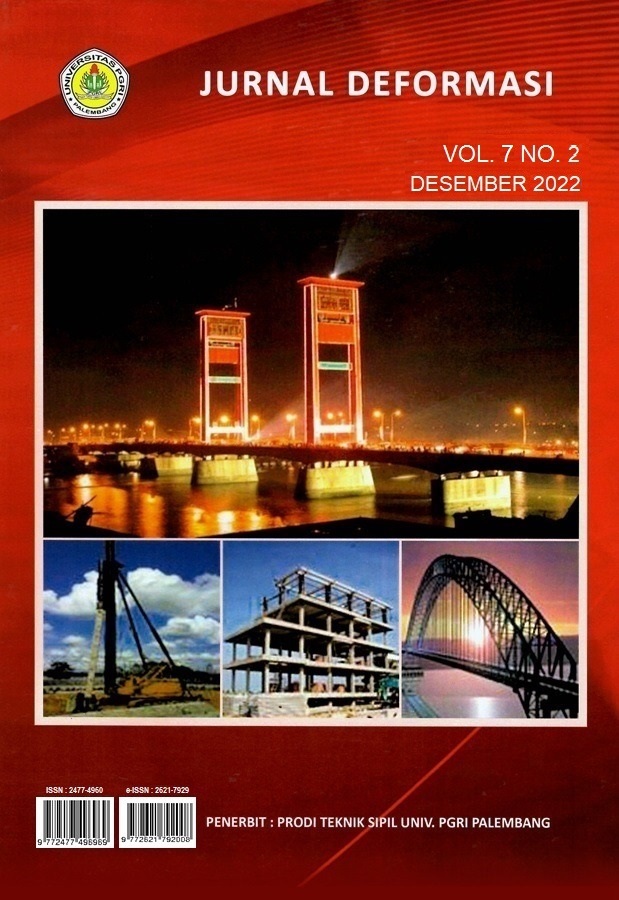STUDI MIKROSTRUKTUR BETON RINGAN GEOPOLIMER DENGAN SCANNING ELECTRON MICROSCOPE (SEM) DAN X-RAY DIFFRACTION (XRD)
DOI:
https://doi.org/10.31851/deformasi.v7i2.9387Keywords:
Beton ringan geopolimer, Mikrostruktur, SEM, XRDAbstract
Beton ringan geopolimer merupakan salah satu beton yang ramah lingkungan karena proses pembuatannya memanfaatkan prekursor yang berasal dari alam dan/atau limbah seperti kaolin, abu terbang, dan pozzolan lainnya. Beton ringan geopolimer ini juga termasuk jenis beton inovasi yang memadukan kelebihan beton ringan dan beton geopolimer. Penelitian ini menggunakan material yang terdiri dari prekursor, larutan alkali aktivator, agregat halus, superplasticizer, dan foam dengan target berat jenis beton ≤ 1500 kg/m3. Prekursor terdiri dari kaolin dan abu terbang dengan persentase kaolin 0%, 5%, 10%, 15%, dan 20% dari berat abu terbang. Perbandingan larutan Na2SiO3 dan NaOH 2,5:1 dengan konsentrasi NaOH 12 M dan 14 M. Perbandingan larutan alkali aktivator dan prekursor sebesar 0,5. Perbandingan agregat halus dan prekursor sebesar 2. Untuk memproduksi foam digunakan perbandingan foaming agent dan air 1:40 dengan presentase foam 50% dari volume campuran. Perawatan benda uji dilakukan selama 24 jam pada suhu oven 60°C. Hasil pengujian kuat tekan beton menunjukkan bahwa campuran BRG-0%-14M menghasilkan kuat tekan yang paling optimum sebesar 19,20 MPa dengan berat jenis beton 1481,12 kg/m3. Hasil pengujian SEM dan XRD menunjukkan bahwa dengan peningkatan konsentrasi NaOH dan persentase kaolin 0% menghasilkan pori-pori yang sangat kecil dan matriks geopolimer yang lebih padat (C-S-H) dengan dihasilkannya struktur geopolimer yang lebih amorf, akan tetapi dengan adanya peningkatan persentase kaolin menghasilkan pori-pori yang semakin besar dan matriks geopolimer yang kurang padat (C-H) dengan dihasilkannya struktur geopolimer yang kurang amorf. Berdasarkan penelitian ini dapat disimpulkan bahwa campuran persentase kaolin 0% menghasilkan mikrostruktur beton ringan geopolimer yang jauh lebih baik.References
Abdullah, M.M.A.B. et al. (2012) ‘Fly Ash-based Geopolymer Lightweight Concrete Using Foaming Agent’, International Journal of Molecular Sciences, 13, pp. 7186–7198. Available at: https://doi.org/10.3390/ijms13067186.
ASTM C 618 (2012) Standard Specification for Coal Fly Ash and Raw or Calcined Natural Pozzolan for Use in Concrete. West Conshohocken: ASTM International. Available at: https://doi.org/10.1520/C0618-12a.
Bakri, A.M.M. Al et al. (2011) ‘Properties And Microstructural Characteristics Of Geopolymers Using Fly Ash With Different Percentages Of Kaolin At Room Temperature Curing’, Australian Journal of Basic and Applied Sciences, 5(10), pp. 824–828.
Bakri, A.M.M. Al et al. (2013) ‘Microstructure Studies on Different Types of Geopolymer Materials’, Applied Mechanics and Materials, 421, pp. 384–389. Available at: https://doi.org/10.4028/www.scientific.net/AMM.421.384.
Demir, I. et al. (2018) ‘Examination of Microstructure of Fly Ash in Cement Mortar’, International Journal of Advances in Mechanical and Civil Engineering, 5(1), pp. 49–51. Available at: http://iraj.in.
Diaz, E.I., Allouche, E.N. and Eklund, S. (2010) ‘Factors Affecting The Suitability of Fly Ash as Source Material For Geopolymers’, Fuel, 89(5), pp. 992–996. Available at: https://doi.org/10.1016/j.fuel.2009.09.012.
Ghais, A. et al. (2014) ‘Performance of Concrete with Fly Ash and Kaolin Inclusion’, International Journal of Geosciences, 05, pp. 1445–1450. Available at: https://doi.org/http://dx.doi.org/10.4236/ijg.2014.512118.
Ibrahim, W.M.W. et al. (2017) ‘Effects of Sodium Hydroxide (NaOH) solution Concentration on Fly Ash-Based Lightweight Geopolymer’, AIP Conference Proceedings, 1885(020011), pp. 020011–1–020011–8. Available at: https://doi.org/10.1063/1.5002205.
Mahmoud, A.S., Khoshnaw, G.J. and Mahmood, F.I. (2017) ‘Engineering and Microstructures Characteristics of Low Calcium Fly Ash Based Geopolymer Concrete’, Eurasian Journal of Science & Engineering, 2(2), pp. 27–39. Available at: https://doi.org/10.23918/eajse.v2i2p27.
Neville, A.M. (2011) Properties of Concrete. 5th edn. England: Pearson Education Limited.
Onprom, P., Chaimoon, K. and Cheerarot, R. (2015) ‘Influence of Bottom Ash Replacements as Fine Aggregate on the Property of Cellular Concrete with Various Foam Contents’, Advances in Materials Science and Engineering, 2015, pp. 1–11. Available at: https://doi.org/http://dx.doi.org/10.1155/2015/381704.
Ramalingam, M. et al. (2022) ‘Flexural Performance and Microstructural Studies of Trough-Shaped Geopolymer Ferrocement Panels’, Materials, 15(5477), pp. 1–19. Available at: https://doi.org/https://doi.org/10.3390/ma15165477.
Sumajouw, M.D.J. and Dapas, S.O. (2013) Elemen Struktur Beton Bertulang Geopolymer. Yogyakarta: Andi.
Sutama, A. et al. (2019) ‘Properties And Microstructural Characteristics Of Lightweight Geopolymer Concrete With Fly Ash And Kaolin’, International Journal of Scientific & Technology Research, 8(07), pp. 57–64. Available at: https://www.ijstr.org/paper-references.php?ref=IJSTR-0619-20484.
Downloads
Published
How to Cite
Issue
Section
License

Authors retain copyright and grant the journal right of first publication with the work simultaneously licensed under a Creative Commons Attribution-NonCommercial-ShareAlike 4.0 International License that allows others to share the work with an acknowledgement of the work's authorship and initial publication in this journal.



.png)
.png)


